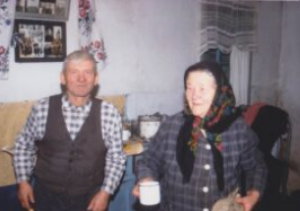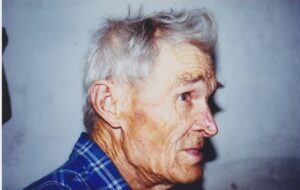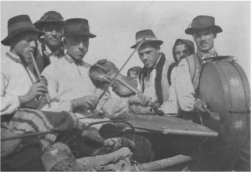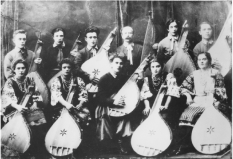Mykola Panteleimonovych Sokyrko (Cherkasy region)
Mykola Panteleimonovych: In 1933 so many people died. Do you see that piece of land over there without any houses? [Before the famine] three families lived there. All of them died of starvation. At this end where a nice house stands, there used to live a woman and she died of famine too. I studied in the Art Institute in Kyiv and came home for school breaks. You know, it was a horrible state: I would come from Vilshany and see a cart in the fields carrying something and about fifty people walking behind it. I guessed that they were taking the bodies to the cemetery. I took a shortcut to go there too, and I saw a dead horse on the road. The people made so much fuss over it. Each was trying to get a piece of the carrion. When I was in Kyiv, terrible things were happening there, too. People from nearby villages would come to the city because in the city people got four hundred grams of bread, and the working people got eight hundred grams or so. Mothers with children sat next to houses begging for food. I saw a lot of this as a student. We used to get four hundred grams of bread; it was difficult, too. The soup wasn’t good. They would just boil cucumbers, and the four hundred grams of bread was not enough. I saw how the condemned people walked down Velyka Zhytomyrska street toward the Lukianivska prison —from the city center where the monument to Bohdan Khmelnytsky was—those were the court locations where people were tried, and after court they were escorted down Velyka Zhytomyrska street. I used to walk by and saw it all. A car would transport the old people, and the younger men would walk behind the car, then women with children. One woman was with four children. She carried one in her arms and held the other one by the hand. This was a horror. One old man [being taken to prison] threw himself in front of a tram. I witnessed his death. People flocked to the site. I didn’t see how exactly he was injured, but I know that he died. He knew that very few people survived the Lukianivska prison, so he decided to take his life.
—What did people think was the cause of the famine? Was it created on purpose?
Mykola Panteleimonovych: People understood that it was on purpose. Do you think people are stupid? For instance, you would get a couple of kilograms of flour somewhere and you would bake a little something. Then comes a special brigade and takes everything away. Why did they take the last grain and the last kilogram of flour from the person? This was all done on purpose. And everyone understood that these were not our brothers and not our administrators.
—Later on, did you happen to hear words of repentance from the people who did this?
Mykola Panteleĭmonovych: No, they were silent about it. I had a friend here, and her father was seemingly a good man, but then he was part of the “red broom” [chervona mitla—brigades that repressed villagers and robbed them with kolhosp encouragement]. They came to my wife’s sister. She said, “They would find a kilogram of flour and take it.” Who permitted them to confiscate the last kilogram of my four? There were some people in the village who—how should I put it?—would suck up to the authorities and be in favor. My wife’s sister’s husband protested. He was told, “Go search people and confiscate the grain.” And he said, “I won’t go.” He left the village for Dniprelstan and worked there. He was an accountant. I also want to tell you a story about one person. He was the father of my former classmate. He seemed to be a smart man, but he, too, was among the “red broom.” He was one of the people who came to my wife’s sister’s house, took everything, and shouted at me, “What are you standing here for? Go on, show us what you got.” They took the last produce we had. Tell me, what can such a person think? Is this done on purpose or not? Of course, it was on purpose. When I came [home] for a break from school, the head of the village council asked me, “Go and document who died and who survived in this kutok [corner] of the village.” So, I went from house to house; I walked into one house and saw a body with the eyes open. I felt cold shivers running down my spine. I waked into the next house and saw the bodies of two children. I could not go any further. I went to the village council and said, “Here, take your books. I won’t do this anymore.” — “So, you are against Soviet power?” — “No, not against, but my temperament will not allow me to do this. I come in and see a body. You know, I’ve never seen the dead, and suddenly I saw them there.”
Mykola Panteleimonovych Sokyrko (Cherkasy region)
—Was the pay equal?
Mykola Panteleimonovych: No, they got paid much less. People would get something like two hundred grams of bread per workday. If a worker did a workday, they would just record one a mark for him. They gave us two hundred grams per workday, and one would earn a bag of wheat in a year; that was it—go try to live off of that.
Mykola Panteleimonovych Sokyrko (Cherkasy region)
—At what age did someone start working in the kolhosp?
Mykola Panteleimonovych: At the time, both the adults and the little ones worked in the kolhosp. The little ones grazed the cattle, and we the adolescents aged fifteen or so used to weed the crops using hoes. No one had time to play.
Mykola Panteleimonovych Sokyrko (Cherkasy region)
—Were there cases of an icon restoring itself [on its own]?
Mykola Panteleimonovych: Not in our village. I haven’t head of this. I know that if it hadn’t rained for a long time, the priest would organize a khresnyi khid to the lake of Mohorychiv that [Taras] Shevchenko wrote about, near Budyshche. There’s a well there called Svizha Balka. They would bless that well and walk back. And then near the village it would rain in torrents, such heavy rain! This I remember. I was twenty-two when I became a choirmaster; I had a small choir of up to thirty people, but there were older singers and the base was there; it was easy to work with them. One tenor (now deceased), Ivan Andriiv, was in Tiutiunnyk’s army belonging to Petliura [Symon Petliura, president of the Directory of the Ukrainian National Republic—Ed.]. This man had bad luck ever since he came back from the war. He ended up getting arrested. People used to say he lost his mind in prison; he was tortured. He had a great tenor voice. I wanted to have him in the choir no matter what; he was so poor and used to wear old rags. I had a new coat and told my wife that I’d give him my old one. He wore that coat for five years. He sang in the choir, and then he was arrested.
Mykola Panteleimonovych Sokyrko (Cherkasy region)
—Do you remember any bohomazy?
Mykola Panteleimonovych: We had one painter: Lukian Hryhorovych Horsky. He graduated from the Kyiv Orthodox Christian Art School named after Murashkin; before that he worked as a self-taught painter in Pochaiivska Church. When he graduated from art school, he came to our village to teach and paint icons. I saw them.
—Did people come to him to commission icons?
Mykola Panteleimonovych: Yes. I must add that he was a very good icon painter. It was not craft, but art.
—Were the icons painted on wood?
Mykola Panteleimonovych: He painted both on wood and on canvas. He was the only painter in our village; I don’t know any other ones.
—How much did he charge for a commission of two icons?
Mykola Panteleimonovych: At the time, it was around thirty to forty karbovantsi.
…………………………………………………
—When you were little, how many icons were there in your house?
Mykola Panteleimonovych: At times we had two, and at times—ten. They were placed in both directions from the corner of the room; we had many of them. I used to organize koliadky and shchedrivky; I was the second voice, and my friend was the first voice, a treble. We used to sing together. One time—I still remember this—we came to the house of Ivan Kyrychenko. He was a respected and religious man, and his house was like the one described in Taras Bulba, I promise. In the middle there was a large painted beam, no hallway, just one spacious room, not fewer than ten icons, and an entryway with pottery, bread, and the burning candles. We sang one song, but he wouldn’t let us go, so we sang about five songs; he loved them so much. Then he treated us to stuffed pastries and kovbasa. We were barely able to leave.
Mykhailo Sokyrko
—When you were taking the course in 1936 [from NARKOMOS], did you feel any
danger at the time?
Mykola Panteleimonovych: Yes, each of us thought at the time that someone could come to arrest us. We had some fear, but we were very much taken by our work.
Later on, I found out that most of the [NARKOMOS] teachers were shot
[largely in 1938].
Mykola Sokyrko
—Did the organization of music by NARKOMOS start during collectivization?
Mykola Panteleimonovych: Yes. We had culture in the village before: the choir,
amateur performances, theater, and orchestras. All of this was before collectivization.
It all started during Lenin’s time. People took an interest in it. There was a good deal
of enthusiasm. Everywhere in the village, you could hear songs. Then all of this other [i.e., Stalinism] began sometime during collectivization, and everything disappeared.
Life got harder. Enthusiasm disappeared.
Mykola Panteleimonovych Sokyrko (Cherkasy region)
Mykola Panteleimonovych: I loved to sing since I was little. In school, we had a very good choirmaster from 1921 to 1930. I was a student in the art department, and we had a good director there, too. In the army, I was the choirmaster of the soldier choir, but I came back. When I was a student in the school choir, I was interested in the fiddle. The choirmaster played the fiddle, and I started learning from him. This was around 1925. Then I made fiddles and balalaikas.
I started learning to play fiddle using sheet music. After the army, I became a teacher. I was the choirmaster in the school choir and later in the village choir. The fiddle helped me a great deal. In 1936, I went to the national course for choirmasters in the Kyiv Conservatory [NARKOMOS, organized by the People’s Commissariat for Education]. There were 120 people there from all over Ukraine: ten women and the rest were men. Hryhorii Hryhorovych Viriovka was the course leader. They taught piano, fiddle, and folk instruments. I studied fiddle and learned much about music. The teachers were excellent: Hrinchenko, Kavun, and Khvylia. Later on, most of them were executed.
After the course, I continued to teach and lead the school choir. Three times we won the first place in the regional competition. I had a Pioneer choir and sometimes I worked with the older guys and girls. At another time, I was a choirmaster of the choir that took the first place in the national competition in 1956.
—When you were taking the course in 1936, did you feel any danger at the time?
Mykola Panteleimonovych: Yes, each of us thought at the time that someone could come to arrest us. We had some fear, but we were very much taken by our work. Later on, I found out that most of the teachers were shot.
[…] I often taught at the regional and district seminars for the music teachers. I taught the theory of music, singing, and teaching methods of choir singing.
—Who paid for your course back in 1936?
Mykola Panteleimonovych: I funded it. I didn’t pay for the course, but neither did I get any scholarship money. The course was organized by the People’s Commissariat of Education [NARKOMOS]. It had the department of amateur performances.
—Did anyone from the National Commissariat or its department come here, to the village?
Mykola Panteleimonovych: Yes, [Hryhorii] Petrovsky did. He was the head of the Supreme Council of the republic, the Ukrainian starosta.
—What did he say?
Mykola Panteleimonovych: He came right when collectivization began, and they set up an example of what a kolhosp should be like in our village—the commune of a few hectares where people sowed and harvested crops. On that plot of land, several families demonstrated how farming could be done. Then they started engaging people in the kolhosp, mostly by force. Whether you wanted or not, it was Stalin’s order to join the kolhosp. Stalin rushed this because it was easy to confiscate the grain through the kolhospy.
—Did the organization of music by the People’s Commissariat start during collectivization?
Mykola Panteleimonovych: Yes. We had culture in the village before: the choir, amateur performances, theater, and orchestras. All of this was before collectivization. It all started during Lenin’s time. People took an interest in it. There was a good deal of enthusiasm. Everywhere in the village, you could hear songs. Then all of this other began sometime during collectivization, and everything disappeared. Life got harder. The enthusiasm disappeared somewhere.
—Did all the concerts in the 1930s start with the songs about the party?
Mykola Panteleimonovych: Yes, the first song had to be about the party. You could get punished for other songs.
[…] During collectivization, we sang the song from the play God Almighty, Watch over Ukraine [Bozhe velykyi, yedynyi, nashu Vkrainu khrany] in the church. The Cossacks kneel when they sing it. We had an autocephalous church. I was accused of singing Ukraina. They needed to arrest the priest because the autocephalous church was prohibited. The accusations against him were fabricated. The deacon reported on him and said that the choir sang Shche ne vmerla Ukraiina. I suffered because of this song.
—How long were you sentenced for?
Mykola Panteleimonovych: They gave me five years. I served my sentence in Norilsk. The ensemble “Trembita” from Lviv was there, too. I was a choirmaster there: twenty-six “Trembita” members, all different voices. During the war, they performed in the opera theater in Kazakhstan. Then a case was opened [Soviet power prosecuted them], and they were all sent to Norilsk. Today, all of them are exonerated. They are all retired. Back in the day, I sang with them. I organized a choir in another camp there, too. It was a very strong choir, great voices.
—You said that musical life was different before collectivization?
Mykola Panteleimonovych: There was more enthusiasm, liveliness, more interest and joy.
…………………………………………………………………………………
—Why did you want to do the course from the People’s Commissariat if they didn’t pay you anything?
Mykola Panteleimonovych: You know, first of all, I was selected after they heard my choir. I loved this work and wanted to learn more about it.
—Were you the choirmaster at the time?
Mykola Panteleimonovych: Yes, since 1934 and I did that course in 1936. I started working as a choirmaster in 1921. The previous choirmaster left the village, and there was no one to lead the choir. The head of the village council summoned me and asked me to take over. At the time, I was a choirmaster in the school.
—Did you rehearse in the House of Culture?
Mykola Panteleimonovych: We had a very primitive club at the time with about 250 seats. The reading room was in the house that later became the priest’s house. There were various hobby groups, and we sang in the club.
—Were you paid as a choirmaster?
Mykola Panteleimonovych: No, I was not paid. I started getting paid in the last five years—fifty rubles from the kolhosp. I was in charge not only of the choir, but of the drama group.
—Did you perform at your own cost?
Mykola Panteleimonovych: Yes, we borrowed the costumes from village residents. We could also find some costumes in the club.
—Who is this man wearing the commissary uniform and sitting next to your first choir in the photo?
Mykola Panteleimonovych: This is the director of the club.
—Was he a commissar [a high-ranking activist]?
Mykola Panteleimonovych: No, the club’s director, a party administrator who was responsible for everything.
—Did you feel the pressure from the party or Komsomol activists in 1937, 1938, and 1939?
Mykola Panteleimonovych: Before we could perform, we had to put together the repertoire and show it to them for approval.
—Where did you take the repertoire from?
Mykola Panteleimonovych: Year after year, I collected various songs from different songbooks. I’d hear something on the radio and look for it in books. Our main task was to serve the revolutionary holidays: the October holidays, Lenin’s day, and May 1. Outside of this, we performed in other villages. I led a choir of five hundred people in the village for Shevchenko’s 150th anniversary. There were four voices [i.e., SATB]. They sang so well, in harmony.
—Is it true that there were more holidays after the war than before it?
Mykola Panteleimonovych: No, it was the same.
From border to border
Over the mountain tops
Where the eagle soars free
The people sing
A beautiful song
About our wise, dear, and grand Stalin.
Aleksandrov wrote this melody.
…………………………………………………………………………………
—Did you have to sing Russian songs?
Mykola Panteleimonovych: No, no one gave us such orders.
—Did the party leaders say anything to you after the concert, if it was good or bad?
Mykola Panteleimonovych: You know, if you sing well, anyone will tell you that it was good.
—Did you have an internal censor? Could you include a song about Doroshenko, for example?
Mykola Panteleimonovych: No, we didn’t take this song. We sang it in the army.
—Why wouldn’t you include it in the choir program?
Mykola Panteleimonovych: You were not allowed to say the word “Ukraine” at the time. You had to say, “Ukrainian Soviet Republic.” If you ever said “motherland,” just give up all hope. You could not show [Ukrainian] patriotic national feelings even though everyone had them. When activists came from Kyiv, I always told them that we didn’t have enough songs about Lenin and the party: too many folk songs, too few contemporary songs. This was the order from the People’s Commissariat, but we still sang Ukrainian songs and staged Ukrainian plays although there were only a few Ukrainian songs at Shevchenko’s anniversary.
Mykola Sokyrko
—What instruments were in the ensembles that played at the weddings?
Mykola Panteleimonovych: A fiddle, a bass [?], a cello [?], and a bubon.
—So, you had a bass in the 1920s?
Mykola Panteleimonovych: Yes.
—What kind of bubon was it?
Mykola Panteleimonovych: The one with a lid on top, a long one.
—Did you have a bubon with two heads [i.e., baraban] in the 1920s or later on?
Mykola Panteleimonovych: Later on, we started getting baian and harmonia.
Mykola Panteleimonovych Sokyrko (Cherkasy region)
—What instruments were in the ensembles that played at the weddings?
Mykola Panteleimonovych: A fiddle, a bass [?], a cello [?], and a bubon.
—So, you had a bass in the 1920s?
Mykola Panteleimonovych: Yes.
—What kind of bubon was it?
Mykola Panteleimonovych: The one with a lid on top, a long one.
—Did you have a bubon with two heads [i.e., baraban] in the 1920s or later on?
Mykola Panteleimonovych: Later on, we started getting baian and harmonia.
—This was in the 1930s. How many strings did the bass have?
Mykola Panteleimonovych: Four strings.
—Were they from stores?
Mykola Panteleimonovych: No, I don’t know where they got the instruments.
…………………………………………………………………………………
—Did the muzykanty play in the tavern?
Mykola Panteleimonovych: Yes, there was music in the tavern, too.
—Were those the same muzykanty that played at weddings?
Mykola Panteleimonovych: Andrii was the same musician, and I don’t remember the others.
—Did Andrii have students?
Mykola Panteleimonovych: No, he was blind and made ropes; he had some kind of a tool for this. He got orders from people to make ropes.
—Did people pay him?
Mykola Panteleimonovych: Yes, he made a living that way.
…………………………………………………………………………………
—Do you remember the village muzykanty?
Mykola Panteleimonovych: I remember the blind Andrii Shevchenko who played the fiddle. Then we also had a bubon, a cello, and a bass. I don’t know where the players got their instruments from.
—How did they call it?
Mykola Panteleimonovych: Bas. It sounded so fine. When this old man got ill and couldn’t play anymore, a harmonia player turned up. There was a lot of enthusiasm for music. Each house had a guitar or a balalaika. This was before collectivization. After it, people started fleeing the village to Donbas to earn some money. There was no time to play.
…………………………………………………………………………………
—Was there a harmonia before collectivization?
Mykola Panteleimonovych: Yes, starting in 1927 or 1928. Someone brought it from his army service in Russia.





